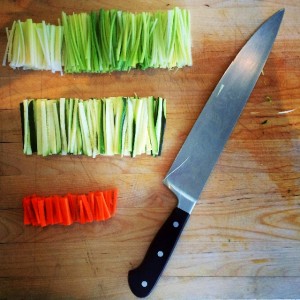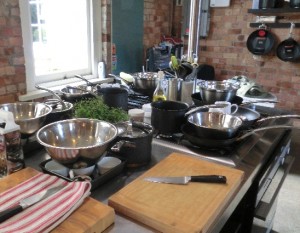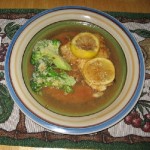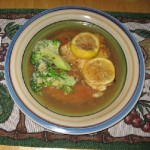 I’ve liked to cook from an early age. I suppose it started with visiting my grandparents and soaking in the smells when my grandmother was preparing the sauce and meatballs for Sunday dinner. It was my personal nirvana! I also loved to “help” my mother bake pies and cookies. The lumps of baked dough I called “cookies” weren’t much to look at and were tough to choke down, but to me they were every bit as good as the fancy cookies from the corner bakery. It was because I made them all by myself!
I’ve liked to cook from an early age. I suppose it started with visiting my grandparents and soaking in the smells when my grandmother was preparing the sauce and meatballs for Sunday dinner. It was my personal nirvana! I also loved to “help” my mother bake pies and cookies. The lumps of baked dough I called “cookies” weren’t much to look at and were tough to choke down, but to me they were every bit as good as the fancy cookies from the corner bakery. It was because I made them all by myself!
The first real thing I learned to cook—after toast—was fried eggs. If you can fry an egg without burning the house down, then you basically know everything there is to cooking for yourself. If you can also open a can, then you’re well on your way to being the next Top Chef.
OK, maybe I’m getting a bit carried away and over confident, but preparing your own meals is not too difficult. The most challenging part is keeping and grocery list and doing the actual shopping. You can still be lazy, but just not too lazy.
Benefits of home cooking:

- Fresh and unprocessed ingredients – it should be assumed that preparing your own meals doesn’t mean tossing a box of Hamburger Helper into a hot skillet with a chunk of ground beef. It does mean using as many fresh ingredients as you can such as vegetables, meat, fish, and poultry. If you choose to use organic and grass-fed versions then go for it. Personally, it’s a bit out of my budget and I’m OK with purchasing the cheaper varieties of fresh food.
- You pretty much know what goes into your food – menu items at restaurants and fast food places are made out of your view – unless you’re eating at a sushi place. My point is, that despite what ingredients are listed on the menu, you can’t be 100% sure of what goes into making it. Perhaps, more importantly, you have even less of an idea of how it’s prepared. Once you start preparing your own meals, you become more sensitive to ingredients and their nutritional content. This in turn, will give you a better perspective on what constitute healthy ingredients. And don’t rely on the server or staff at a fast food restaurant to provide you with reliable information on ingredients and methods of preparation.
- You’ll eat less – the trend for a while at most American dining establishments is to supersize everything. There are 32oz sodas, 1 pound cheeseburgers, and jumbo plates of pasta and seafood to just mention a few items that have been elaphantized. Sure, you can always ask to take home leftovers, but that’s both inconvenient especially is you’re going out somewhere afterwards such as to a bar or movie or just want to take a leisurely stroll after dinner. Not to mention, that the leftovers often turn moldy in the fridge because they don’t looks all that appealing the next day.
- Save money – this point should be obvious, but based on how many coworkers I’ve known over the years that habitually grab lunch away from the office, I’m not so sure. Many of these same people would also stop off at a fast food or pizza joint on the way home in the evening to pick up dinner. It didn’t surprise me that many of them were overweight. As any high school math teacher would preach: “Do the math!” It does add up over time.
- Hygiene – if you’ve ever worked in the food industry then you probably have a good idea of what goes on behind the scenes. There’s a reason for the Board of Health. My first job while still in high school was washing dishes at a country club. You would think an elite establishment such as a country club would have impeccable food storage and preparation standards in their kitchen. It was anything but! It’s also advisable to not upset your server. For reference, view the movie Waiting – the video clip below should be sufficient to get the point across. There are many cases of food poisoning each year in the US – many of them unreported. How often has that happened when you’ve prepared food at home?
- Food will taste better – it may just be me and where I live, but I’m usually always disappointed when I dine out. Frankly, the food leaves a lot to be desired along with the competency and courteousness of the servers. Factor in that it’s an effort to find menu choices that satisfy my particular dietary needs along with the high cost of dining out, then it’s a disappointing experience all around. If nothing else, it makes me appreciate preparing and eating meals at home.
I can hear you saying, “That’s great and all, but who has the time for meal planning and then doing all that cooking?” Glad you asked since I have some helpful tips to deal with those concerns in the form of some simple strategies:
Strategies for preparing your own meals:

- Meal planning – every project begins with a list. Make one on a weekly basis. You don’t need to plan out each and every meal for an entire week. Just having a general idea of what you’d like to eat for a few lunches and particular dinners should suffice. You can fill in the blanks once the day rolls around. By that, I mean having on hand the basic ingredients from which you can throw together a simple and quick meal. Having a large bag of frozen chicken breasts or other parts can server for at least two dinners and possible a lunch or two. Fish filets and steaks can also be stored frozen. Fruit and veggies should be purchased fresh at least weekly along with dairy items such as milk, cream, butter, and of course a variety of cheese. From there it’s a matter of making sure you have the bulk items stocked in your pantry such as cooking oils, snack foods such as nuts and other healthy snack items.
- Learn the basics of cooking – as I mentioned previously, if you can fry an egg you’re well on your way to cooking simple meals for yourself and your family. Of course, you’ll probably get tired of eating eggs at every meal, so you’ll want to learn a few more advance recipes. There are many great meals that you can cook in a glass baking dish such as baked chicken, fish, and vegetable casseroles and bakes. Stir frys are extremely simple and only require a single skillet – pretty much the same as frying an egg. One of the great things about the low-carb and Paleo communities is that they have some of the best cooking and recipes sites on the Web. Below are some of my faves. There are also tons and tons of general recipe and cooking sites to explore for healthy recipes and cooking tips. And don’t forget YouTube!
- Stock up on containers – leftovers are your friends and saviors! With actively practicing portion control, you’ll often find yourself satisfied with half the contents on your plate. Scooping half of the large chicken breast and vegetables into a plastic storage container becomes a quick and easy lunch to take to the office or school the next day. Storage containers also come in very handy to keep chopped veggies at the ready for salads, stir frys, and other main and side dishes.
Getting in the habit of preparing your own meals at home puts you more in tune with what goes into a healthy and great tasting meal. You’ll have a deeper appreciation for selecting quality ingredient while grocery shopping and this will translate in making better choices when dining away from home. Eating out is a great way to treat yourself and for making a fun social occasion with family and friends. It’s also a necessity when traveling. I’ve just found over the years that making dining out the exception rather than the rule has allowed me to stay on track with my way of eating and has also added a fun dimension to everyday living.
Photo Credits (morguefile.com):
- Chopped Veggies: Seeman
- Produce Basket: macroncasin
- Cooking Utensils: Melodi2



Leave a Reply